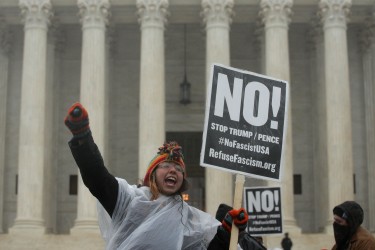Samuel Moyn recently argued in these pages against comparing Trump’s policies to fascism, because his administration is “pursuing causes with roots deep in American history. No analogy to Hitler or fascism is needed to explain these results.” But this presumes that fascism does not have its own deep roots in American history. It is arguable—not to say, exceptionalist—to presuppose that anything indigenously American cannot be fascist; this begs the question of American fascism rather than disputing it. Experts on fascism such as Robert O. Paxton, Roger Griffin, and Stanley G. Payne have long argued that fascism can never seem alien to its followers; its claims to speak for “the people” and to restore national greatness mean that each version of fascism must have its own local identity. To believe that a nationalist movement isn’t fascist because it’s native is to miss the point entirely.
Historically, fascist movements were also marked by opportunism, a willingness to say almost anything to get into power, rendering definitions even murkier. Trying to identify its core, the unsplittable fascist atom, has proved impossible; we are left with what Umberto Eco called fascism’s “fuzziness,” others its “hazy and synthetic doctrines.” There are good arguments against attempting through taxonomies to establish what’s become known as a “fascist minimum,” as if a checklist could qualitatively differentiate fascism from other authoritarian dictatorships. Some think anti-Semitism is a litmus test; others genocide. Does colonialism count? Aimé Césaire, C.L.R. James, and Hannah Arendt, among many other notable thinkers who lived through the first fascisms, certainly thought it did, arguing that European fascism visited upon white bodies what colonial and slave systems had perfected in visiting upon black and brown bodies.
Paxton has argued influentially that fascism is as fascism does. But conspicuous features are recognizably shared, including: nostalgia for a purer, mythic, often rural past; cults of tradition and cultural regeneration; paramilitary groups; the delegitimizing of political opponents and demonization of critics; the universalizing of some groups as authentically national, while dehumanizing all other groups; hostility to intellectualism and attacks on a free press; anti-modernism; fetishized patriarchal masculinity; and a distressed sense of victimhood and collective grievance. Fascist mythologies often incorporate a notion of cleansing, an exclusionary defense against racial or cultural contamination, and related eugenicist preferences for certain “bloodlines” over others. Fascism weaponizes identity, validating the herrenvolk and invalidating all the other folk.
Americans of the interwar period, though they could not predict what was to come in Europe, were nonetheless perfectly clear about one fact we have lost sight of today: all fascism is indigenous, by definition. “Fascism must be home grown,” admonished an American lecturer in 1937, “repeating the words of Benito Mussolini, that fascism cannot be imported,” but must be “particularly suited to our national life.” Logically, therefore, “the anti-Negro program” would provide “a very plausible rallying cry for American fascists,” just as anti-Semitism had for Germans. Others recognized that the deep roots of anti-Semitic evangelical Christianity provided equally plausible rallying cries for an American fascism. Wartime patriotism and the Allied triumph soon gave Americans permission to regard fascism as an alien and uniquely European pathology, but “the man on horseback,” the despot who could ride reactionary populist energies to power, had been a specter in American politics since at least as early as the presidency of Andrew Jackson in the 1830s.












